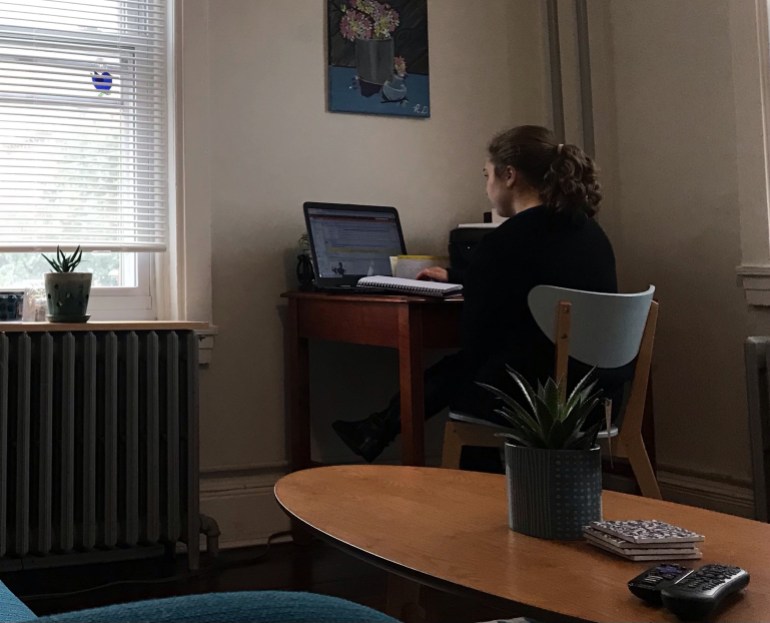Gina DeRosa was thrilled when her year-long internship at the Department of Education in Pennsylvania in the United States turned into her first full-time job out of college.
But two months into her role, DeRosa has never met her colleagues in person. Trained entirely online by her supervisor, who she had met prior to Philadelphia’s COVID-19 lockdown, DeRosa interacts with her coworkers exclusively over Zoom.
“When you work with your colleagues right there, you can just ask them a question and walk [over] to them,” DeRosa, 22, told Al Jazeera. “It was definitely an adjustment.”
Months into the global coronavirus pandemic, the remote working arrangements that felt temporary in the spring are beginning to feel much more permanent.
Earlier this month, three major tech companies – Dropbox, Twitter and Square – all announced they would be letting employees work remotely forever. And even companies that want to bring people back to the office – like media giant The New York Times – say workers won’t be returning until the summer of 2021.
Remote work is, in many ways, a privilege. Thirty-three percent of the American labour force is currently working from home full-time, according to Gallup data, and an additional 25 percent of those surveyed say they work remotely sometimes. But young people and workers of colour are less likely to be employed at jobs that offer remote work arrangements.
 Gina DeRosa, 22, started her first job out of college at the height of the coronavirus pandemic and has worked exclusively from her apartment in Philadelphia, Pennsylvania [Courtesy: Gina DeRosa]
Gina DeRosa, 22, started her first job out of college at the height of the coronavirus pandemic and has worked exclusively from her apartment in Philadelphia, Pennsylvania [Courtesy: Gina DeRosa]Remote work has also been a challenge for many, especially workers juggling caring for babies or managing remote learning for school-aged children. Young people eager to go out into the world and build a name for themselves are also finding it tough.
“For young people that wanted to go out there – you want to meet people, you’re graduating from college, you want to extend your social circle. This is a time when you were going to do that,” Lynn Berger, a New York City-based career coach, told Al Jazeera. “If you’re young and you’re living by yourself, you might really [be] missing that.”
Working from anywhere
When workers were first sent home from the office in the early days of the pandemic, some found silver linings.
Andrew James, 47, a senior account executive for an enterprise software firm, flew from New York City to Miami, Florida in March to be with his long-distance girlfriend of three years.
“This pandemic, weirdly, has made me a father,” James told Al Jazeera of his new living arrangement with his partner and her three children.
James said not having to take the subway every morning, wear a button-down shirt every day and pick up the dry cleaning every week has freed up time for other things – leading to a new work-life balance that he is enjoying.
Even before the pandemic hit, more corporations were embracing the concept of working remotely as a strategic choice, said Prithwiraj Choudhury, an associate professor at Harvard Business School who led a study on the productivity effects of geographic flexibility. The study observed a 4.4. percent causal increase in productivity in a sample of 831 employees who could “work from anywhere”, living and working wherever they chose.
“Work from anywhere has tremendous benefits,” Choudhury told Al Jazeera, adding that remote working arrangements can also be good for the environment, as they reduce carbon emissions when people don’t have to drive to work. Employees in work-from-anywhere arrangements also take fewer breaks and sick days, Choudhury found.
Social support reduces stress on both sides. It's an opportunity to develop those relationships that you kind of put off for a while because you've always been so busy running around.
Childcare crisis
Choudhury’s research doesn’t look at workers’ productivity if they are both caring for children and working, however, which is where many parents are struggling to make remote working viable.
James’s girlfriend’s kids are aged 11, 16 and 17, and he said working remotely has been mostly rewarding, if challenging at times.
“We’re all just getting back into school, and I’ve had various tutoring things [I’ve done],” he explained. “It’s actually more of a challenge trying to find space, making sure we’re not on top of each other.”
 Andrew James, 47, an account executive at Salesforce, relocated from New York City to Miami, Florida after his employer shuttered the company’s offices in March [Courtesy: Andrew James]
Andrew James, 47, an account executive at Salesforce, relocated from New York City to Miami, Florida after his employer shuttered the company’s offices in March [Courtesy: Andrew James]Women, especially women of colour, have been more likely to be laid off, see their careers stall or have their financial security jeopardised during the pandemic, according to LeanIn.org and McKinsey and Company’s Women in the Workplace 2020 report.
More than one in four women are considering downshifting their careers or dropping out of the workforce entirely, the report found, and 865,000 US women dropped out of the US workforce in September alone, according to the Bureau of Labor Statistics.
Of course, not all workers even have the option to work remotely, including domestic workers, childcare workers, service workers and essential workers. That’s also having a disproportionate impact on women, who make up more than 90 percent of domestic and childcare workers in the US, and they are largely women of colour and immigrants, according to the National Domestic Workers Alliance.
I miss overhearing conversations in the office and saying, ‘Oh, that's an interesting approach.’ I miss that sort of in-office learning.
Zoomed out
The pandemic’s abrupt upheaval of people’s routines and the economic hardships that have followed have triggered a mental health crisis. Fifty-three percent of Americans in July said their worry and stress levels have spiked in recent months, a significant jump from 32 percent in March, according to a survey conducted by the Kaiser Family Foundation.
Even workers who are not dealing with depression or more serious mental health issues are reporting feeling burnt-out and pressured to be “on” all the time, said career coach Berger.
“We are all kind of Zoomed-out at this point,” she explained. “It’s very frustrating for many people. It can be very lonely, and it’s not healthy.”
 Gina DeRosa, 22, said working remotely from her parents’ house in New Jersey at the height of the pandemic back in the spring gave her a chance to spend quality time with her brother, Joseph [Courtesy: Gina DeRosa]
Gina DeRosa, 22, said working remotely from her parents’ house in New Jersey at the height of the pandemic back in the spring gave her a chance to spend quality time with her brother, Joseph [Courtesy: Gina DeRosa]A new normal
Remote work arrangements have persisted, even as government restrictions have lifted on workers returning to offices.
Cost-savings could be one factor at play.
“CEOs and CFOs looked at those empty office buildings, and many of them have told me they’re questioning why they need that real estate,” Choudhury said. “If they can sell off a building or not rent it, that’s going to be real savings to their bottom line.”
In New York City’s Manhattan borough, for example, leasing volume in the office real estate market dropped by half quarter-over-quarter in the third quarter of 2020. Meanwhile, asking rent decreased by the sharpest percentage since 2009, Colliers International reported.
A more permanent remote work culture could also give workers flexibility, Choudhury said, such as spouses working for companies based in different regions, or people working from their home countries rather than competing for a small number of US visas.
“You can move to a country that’s cheaper for you, and if the company is not reducing wages, that means you can have more money in your pocket to buy a bigger house,” Choudhury explained. “You can be closer to your aging parents if that is a priority.”
Companies can help remote workers by offering virtual water cooler sessions, Choudhury said, and supporting childcare.
But until company and government support systems for remote workers catch up to this new reality, there is a fair amount of stress that can come with the arrangement.
For now, Berger encourages her clients to do what they can to take care of themselves, including taking time to get outside during the day “if you feel you’re getting a little fried,” she said.
“I think you have to create time in your schedule to reach out to other people,” she added. “Social support reduces stress on both sides. It’s an opportunity to develop those relationships that you kind of put off for a while because you’ve always been so busy running around.”
James’ firm told its employees that they do not need to return to the office until June of next year. James expects that even when employees are asked back, “it may be for only three or four times a week.” And while he misses the bustle of New York City, he could get used to working from anywhere, especially Miami.
“I miss overhearing conversations in the office and saying, ‘Oh, that’s an interesting approach.’ I miss that sort of in-office learning,” he said. “But I’m doing perfectly fine in this kind of remote environment.”
"work" - Google News
October 18, 2020 at 09:43PM
https://ift.tt/3kaPDr7
As new wave of COVID-19 cases hits, remote work becomes the norm - Al Jazeera English
"work" - Google News
https://ift.tt/3bUEaYA
Bagikan Berita Ini















0 Response to "As new wave of COVID-19 cases hits, remote work becomes the norm - Al Jazeera English"
Post a Comment